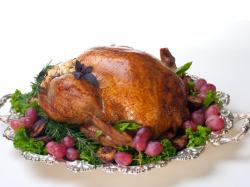Survey Finds Key To Spectacular Holiday Season Starts With Twists On Tradition
October 19, 2010 | 3 min to read

DES MOINES, Iowa — Updating holiday menus doesn't have to mean out with the old and in with the new. Having a bit of fun by mixing up seasonal flavors can reinvigorate comfortable family classics while still evoking cozy memories of holidays past. This is good news for the eight out of 10 people who described their 2009 holiday meals as "predictable," according to the National Pork Board's "Holiday Table Trends 2010" survey. To help inspire twists on traditional dishes and break free from holiday predictability, celebrity chef Michael Symon has created pork pairings inspired by the survey results.
"Pork's versatility makes it my first choice for holiday dinners," said Symon. "I can pair pork with sweet holiday favorites like cranberry and cinnamon – and explore unexpected flavors like chocolate – when recreating holiday classics."
The survey also found that chocolate was a top-rated festive flavor that many people would never consider pairing with pork. But Symon insists that mole, a savory Mexican sauce that incorporates chocolate, is a perfect pork pairing. He created a "Cider-and-Beer-Braised Pork with Chocolate Mole" recipe to show how pork's savory flavor can be enhanced by almost any holiday ingredient.
Festive Flavors That Pair Perfectly With Pork
Perennial classic holiday dishes can easily become delicious new favorites with great-tasting pork and complementary crowd-pleasing seasonal flavors. According to the survey, pumpkin pie, chocolate, cinnamon and cranberry top America's holiday flavor wish list. Whether it's a festive dinner for 20 or busy pre-holiday weeknight meals, try these Chef Symon recipes that unite the essence of pork with favorite holiday ingredients:
- Roasted Rack of Pork with Five Spice Pumpkin Puree – Coriander and cumin reinvigorate the classic combination of tender pork and robust pumpkin. Symon's zesty cilantro salad provides another unexpected accompaniment to this holiday meal.
- Ginger-Crusted Pork Cutlets with Cinnamon-Orange-Cranberry Chutney and Wilted Arugula – Nothing reflects the spirit of the holidays more than the sweet and tart flavors of cinnamon and cranberry. The color, texture and taste of the ginger crust could make this a new family favorite.
- Cider-and-Beer-Braised Pork with Chocolate Mole – Two of America's holiday favorites – cider and chocolate – highlight pork's versatile pairing possibilities. Here, Symon has created a dish that's perfect for any size group – from small meals for four to a holiday feast.
For more about Chef Symon's holiday recipes based on the "Holiday Table Trends 2010" pork survey results, a FREE brochure filled with tips on preparing the holiday's go-to protein and videos for how to celebrate the season with pork, visit www.TheOtherWhiteMeat.com. You can also follow us on Facebook at facebook.com/TheOtherWhiteMeat and @allaboutpork on Twitter.
The National Pork Board has responsibility for Checkoff-funded research, promotion and consumer information projects and for communicating with pork producers and the public. Through a legislative national Pork Checkoff, pork producers invest $0.40 for each $100 value of hogs sold. The Pork Checkoff funds national and state programs in advertising, consumer information, retail and foodservice marketing, export market promotion, production improvement, technology, swine health, pork safety and environmental management.
About The "Holiday Table Trends 2010" Survey
The "Holiday Table Trends 2010" survey was conducted by independent research firm Wakefield Research among 1,000 nationally representative adults ages 18 and older. The study was conducted using an email invitation and an online survey between June 28th and July 2nd, 2010.
Source: National Pork Board
